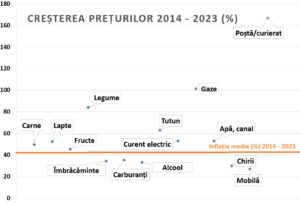
Two contradictory phenomena occur during the development of an economic sector that is vital for development:
on one hand, we have the boom in the construction sector – increase of 8% in the midst of the pandemic, while the economy shrank by 4.6%;
on the other hand, we have imports of 100% of the necessary quantities of concrete-steel used in construction, although, 10 years ago, we imported only 20% of what we needed.
Like the situation of the bitumen that will have to be imported in a proportion of 95% within the big plan of road infrastructure restoration, in the concrete-steel case we also have to use neighbouring states’ production for constructions.
How and why?
Construction – boom and a net contributor to GDP growth
In the first 7 months of the year, construction works increased by 8% compared to the same period in 2019. In the same period, new residential construction works increased by 18%.
In recent years, constructions have contributed by shares between 5 and 7% to the formation of Gross Domestic Product, and last year this sector generated almost 25% of GDP growth, respectively one percentage point of the advance of 4.1%. Moreover, in the first half of 2020, when the economy as a whole registered an annual decrease of 4.6%, constructions partially mitigated this decline, with a contribution of + 0.5 points.
But how much does this sector contribute to the development of a horizontal raw materials industry? One of the basic elements in residential constructions is concrete-steel. How much of the quantity needed for the local market is produced in Romania and how much do we import?
2020 – zero domestic production for a need of one million tons
Currently, there are two large concrete steel producers in Romania: COS Targoviste and Ductil Steel Buzau, owned by Russian company Invest Nikarom SRL. Both companies are in a reorganization process. At COS Targoviste, the activity was stopped at the beginning of the year, while at Ductil Steel Buzau the production was stopped in the first quarter and resumed in April. The outcome? In the first half of 2020, the whole amount of concrete steel that residential building constructors needed came from import.
„In the last 2-3 years, the domestic production has been ensured – continuously or periodically – mainly by 2 producers: COS Targoviste, which ensures its semi-finished products from own production, Ductil Steel Buzau, with semi-finished products supplied from Targoviste (insufficient quantities). Currently, the activity of these units is stopped, with limited prospects of resuming production at Targoviste and Buzau and without any perspective at Focsani. For this reason, starting this year, the entire domestic need of concrete steel is exclusively covered from import”, according to the data provided to cursdeguvernare.ro by the Romanian Association of Metal Distributors (ARDIMET).
Consequently, in the first six months of the year, the local market was 100% dependent on imports totalling 380,000 tonnes. Throughout 2019, the demand was almost one million tons.
From whom we buy everything
The main countries that supply concrete steel to Romania are Turkey, Greece, Bulgaria, Moldova and Ukraine, in this order.
Ten years ago, the largest suppliers for the local market were companies from Turkey, Hungary, Italy, Greece, and Bulgaria.
The product, brought to the country in the form of bars and rolls and later shaped by the distributor, currently costs about 2.5 RON / kilogram.
In terms of price, concrete steel in Romania has become about 10-15% more expensive than the one from import. However, ARDIMET representatives claim that local products partially compensate for this gap by quality, as the concrete steel produced at COS Targoviste, for example, is extremely reliable and malleable and can take a variety of shapes.
However, the price gap also seems to be generated by the fact that, in Romania, the energy price, which represents about 40% of the total cost of concrete steel, is higher than in most countries from where we import, respectively Turkey, Bulgaria or Ukraine.
Fewer plants, less concrete steel
Total import in 2020 was „prepared” step by step in previous years when local demand was served by more and more imports. In 2019, in Romania, about 80% of the concrete-steel used in civil constructions came from abroad, according to the data provided by ARDIMET.
Specifically, in 2019, the total amount of concrete steel used on the local market was 978,000 tons, of which 803,000 tons, respectively 82%, were imports. The rest, of approximately 179,000 tons, was represented by the internal production of COS Targoviste and Ductil Steel Buzau.
In 2018, so two years ago, Romania imported a total quantity of 700,000 tons (80.4% of the market demand), and domestic production (made by the same two companies) amounted to 170,700 tons. The volume of the entire market was 870,000 tons.
The situation in 2019 and 2018 sharply contrasts with what happened 10 years ago, in 2008, when 7 concrete steel producers were active on the local market, namely MECHEL Targoviste, DUCTIL STEEL Buzau, MECHEL Campia Turzii, ArcelorMittal Hunedoara, OTELINOX Targoviste, LAMDRO Turnu Severin and Laminorul Focsani. In 2008, the seven companies produced 944,000 tons, twice the imported quantity, respectively 468,000 tons. Also in 2008, the market demand was 1,184,000 tons, which means that domestic production could cover 80% of local demand. As local producers exported about a quarter of what they produced, domestic production supplied the construction market with „only” 60% of the concrete-steel need.
Perspectives
Currently, the concrete steel industry in Romania depends on the future of the two plants, from Targoviste and Buzau, given that other units operating in 2008 were closed (the plant from Campia Turzii), and other left this market to focus on other products.
However, it is not excluded that new production capacities would appear.
„Regarding the medium and long term perspectives, there are known some concerns of LIBERTY Group to start an opportunity analysis of an investment in Galati Plant for producing concrete steel by building a modern flow consisting of a machine for continuous casting of tiles and a concrete steel rolling mill”, ARDIMET representatives mentioned for cursdeguvernare.ro.









